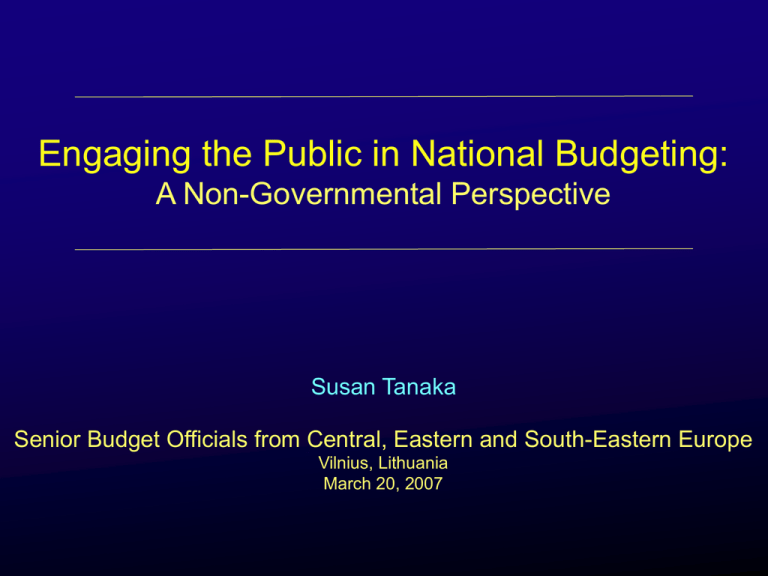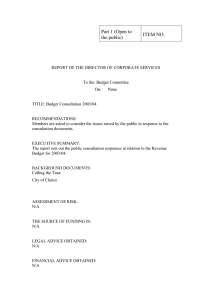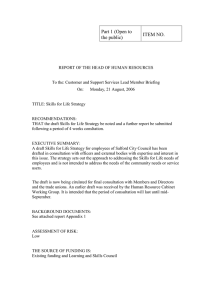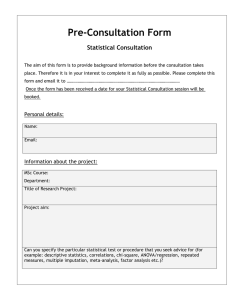Engaging the Public in National Budgeting: A Non-Governmental Perspective Susan Tanaka
advertisement

Engaging the Public in National Budgeting: A Non-Governmental Perspective Susan Tanaka Senior Budget Officials from Central, Eastern and South-Eastern Europe Vilnius, Lithuania March 20, 2007 Overview • • • • The problem: Why be concerned about public engagement in national budgeting? What is public engagement? What can budget officials do to support it? (with examples) What can others do to support it? (with examples) Why Public Engagement? Goals • Good Government: Improve Efficiency, Transparency, Accountability ‣ ‣ ‣ • Better-functioning democracy Improved citizen oversight Greater trust in government Better Budget Outcomes: Create a constituency for fiscal responsibility ‣ ‣ Better informed and more realistic citizens Build support for responsible fiscal policies that require establishment of priorities, trade-offs and compromise to find common ground Problem: The potential for a wide--and serious--disconnect between citizens and leaders What Citizens See What Leaders See •“Black box” of budgeting and •People “wanting it all” but decision-making unwilling to pay for it •Powerful special interests •An uninformed public that has and partisanship little of value to offer policy making •Little of value being done to •Apathetic citizens who do not address challenges want to be engaged •Experts are running the show •Activists hijack all attempts at public dialogue Source: Viewpoint Learning, 2004 The Cost of Citizens’ Mistrust of Government The main obstacle to building public support for difficult choices on our nation’s finances and future is not public opposition to tax increases or program cuts, nor is it lack of interest; the main obstacle is deeply felt and pervasive mistrust of government. “Americans Deliberate Our Nation’s Finances and Future: It’s Not About Taxes--It’s About Trust” Viewpoint Learning An Opportunity Citizens are: • • • • Eager to become engaged, but lack opportunities Able and willing to address complex policy issues Willing to set aside initial biases and opinions to learn, discuss, debate and compromise Willing to accept unpopular tax increases and spending cuts as long as two conditions met: ‣ ‣ Solve the problem Everyone contributes to the solution --Findings from The Exercise in Hard Choices What is Public Engagement? Existing Emphasis: Consultation and Control • • OECD: government connects with citizens to close distance and create a two-way flow of information to counter public cynicism and mistrust World Bank: citizens at large or through organized civil society organizations (CSOs) work directly or indirectly to influence decisions and make government more responsive and accountable (social accountability) Problem: Public engagement concepts that work at the municipal level don’t work at the national level • • • Practical barriers to greater citizen participation multiplied at the national level ‣ Distance is the reality--proximity not possible ‣ Issues are NOT local: instead are very complicated ‣ Scale is a factor--individual citizens cannot have influence Consultation: How much weight to uninformed opinion? Control: How much decision-making to cede to citizens? Solution: Broader Concept that Suits National Requirements New Focus: Education and Better Information • • Public engagement = people’s expression of their commitment to their community through participation in civic and political life* Building civic capacity: informed public judgment about issues ‣ ‣ ‣ Target general public--unorganized individuals or those affiliated to CSOs Promote understanding of budget policy Provide a context to weigh common objectives and improve community life * From Philanthropy for Active Citizen Engagement.--U.S. organization of private charities and foundations that fund engagement activities What Can Budget Officials Do? OECD’s Framework for Interaction with Citizens: • • • Information--Top down: one-way flow ‣ ‣ Passive--available for anyone who seeks it out Active--government makes an effort to get the public’s attention Consultation--Top down/Bottom up: Two-way flow of information Direct Engagement--citizen participation in the decision making process. (Not applicable at national level) Focus on Information: Enabling Public Engagement • • • • Pre-requisite to an informed public debate Virtuous cycle: Information-transparency-accountabilityengagement-more information-greater transparencyimproved accountability-more engagement . . . . No excuses: Technology-driven expectations for disclosure of budget information and growing limitations on government’s ability to control Quality more important than quantity ‣ ‣ ‣ ‣ Accurate and credible Comprehensive Timely Accessible--presentation and organization Information Budget Office Websites • • Best offense: ‣ ‣ Direct, unfiltered communication to citizens Demonstrates openness and enhances credibility Best defense: ‣ ‣ Information vacuum eases proliferation of misinformation Official information provides common frame of reference Information Examples: Budget Office Websites • Passive Information ‣ ‣ ‣ U.S., Office of Management and Budget: http://www.whitehouse.gov/omb/ Australia, graphs, Commonwealth Budget: http://www.budget.gov.au/2006-07/overview/html/overview_30.htm Department of Finance, Canada, multimedia presentation, Where Your Tax Dollar Goes: http://www.fin.gc.ca/taxdollar06/mm/taxdollars0506_e.html 2 clicks Information Examples: Budget Office Websites (continued) • Active-Interactive Sites ‣ ‣ France: Ministry of Economics and Finance Forum de la Performance: http://www.performance-publique.gouv.fr/ • • BudgetFlash Cyberbudget UK: HM Treasury 2007 Comprehensive Spending Review: http://csr07.treasury.gov.uk/ Consultation Examples: Government-Sponsored Active Listening / Public Education • • Electronic Discussion (asynchronous) ‣ France: Les Forums --How to reduce the public debt: http://www.forums.gouv.fr/article_archive.php3?id_article=115 On-Line Public Consultation ‣ Canada: Consultation on Restoring Fiscal Balance: ‣ Hong Kong: Tax Reform: http://www.fin.gc.ca/activty/consult/fiscbal_e.html http://www.taxreform.gov.hk/ What Others Can Do Non-Governmental Public Engagement Activities • Public Policy Research Organizations--”Think Tanks” ‣ ‣ International Budget Project: http://www.internationalbudget.org/index.htm National Budget Group -Azerbaijan: http://www.nbg.az/ What Others Can Do Non-Governmental Public Engagement Activities (continued) • Public Education and Outreach ‣ U.S. Concord Coalition, public forums, Fiscal Wake-Up Tour: http://concordcoalition.org/events/fiscal-wake-up/index.html ‣ U.S. interactive, educational website , California Next Ten: http://nextten.org/index.php Informal Public Engagement: Unorganized Initiatives "A few years ago the debate was about whether the media controlled politicians or whether politicians controlled the media... Now it is about how we are all responding to the explosive power of citizens, consumers and bloggers.” Chancellor Gordon Brown, Davos, January 25, 2007 • Google search for “United States Budget”--57,100,000 hits ‣ 3rd resource = Wikipedia, United States Budget Process: http://en.wikipedia.org/wiki/United_States_budget_process • • Blog search “United States Budget”--149,000 postings The Budget Graph: http://thebudgetgraph.com/view Public Engagement: Conclusion • • Goals ‣ ‣ Build civic capacity Budget Officials’ Role ‣ ‣ • Good Government/ Better Budget Outcomes Essential contribution: Information that informs and allows others to inform Quality of information matters A Cautionary Note ‣ ‣ Focus on the objectives Manage the public’s expectations Susan Tanaka susan_tanaka@verizon.net Senior Budget Officials for Central, Eastern and South-Eastern Europe Vilnius, Lithuania March 20, 2007




